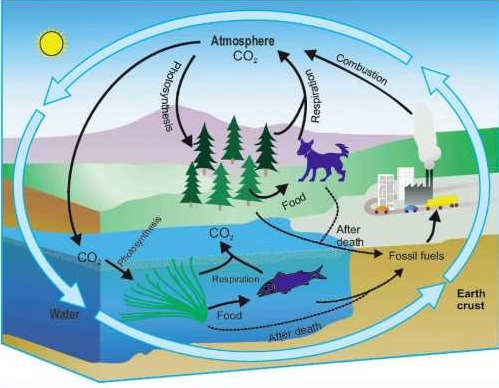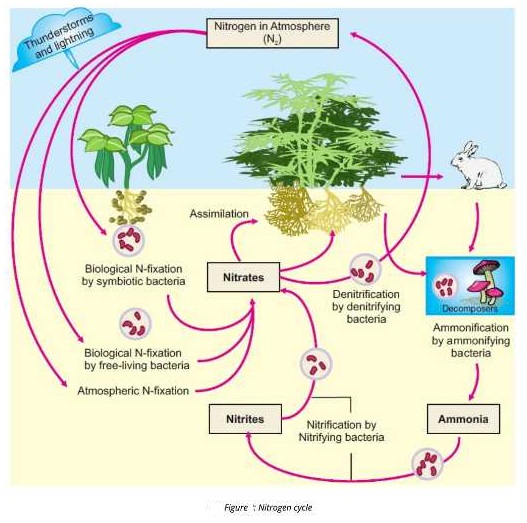Q.7 Define biogeochemical cycles. Also explain different cycles in ecosystem.
Answer:
Source of bioelements
Environment provides bioelements which are used by organisms for their bodies and metabolism. The materials are continuously recycled between organisms and environment. They are also called nutrient cycles.
Biogeochemical cycles
Biogeochemical cycles are the cyclic pathways through which materials move from environment to organisms and back to the environment.
1. Carbon Cycle
Introduction
Carbon atom is the principal building block of many kinds of biomolecules.
Occurrence of Carbon
Carbon is found as graphite and diamond in nature. It also occurs as carbon dioxide in atmosphere.
Sources of Carbon
Major sources of carbon for the living world are:
• Carbon dioxide present in atmosphere and water.
• Fossil fuels like peat, coal, natural gas and petroleum also contain carbon.
• Carbonates of Earth’s crust also give rise to carbon dioxide.
Effects of upsetting of carbon cycle
The balance of carbon cycle has been upset by human activities such as deforestation and excessive burning of fossil fuels, As a result, the amount of carbon dioxide in atmosphere is increasing, causing the green house effect and global warming.

Steps of Carbon Cycle
(a) Entry of Carbon into Living Organisms
The major process that brings carbon from the atmosphere or water into living world is photosynthesis.
(b) Transfer of Carbon
Producers take in carbon dioxide from atmosphere and convert it into organic compounds and becomes a part of the body of producers. This carbon enters in food chains and is passed to herbivores, carnivores and decomposers.
(c) Release of Carbon
• Carbon dioxide is released back to environment by respiration of producers and consumers.
• It is also released by the decomposition of organic wastes and dead bodies by decomposers.
• Burning of wood and fossil fuels also add large amount of carbon dioxide into atmosphere.
2) Nitrogen Cycle
Importance of Nitrogen
Nitrogen is an important component of all biomolecules like proteins and nucleic acids (DNA and RNA). These are the most abundant biomolecules in the body of all living organisms.
Unavailability of molecular Nitrogen
Atmosphere is the reservoir of free gaseous nitrogen. Living organisms are unable to use this gaseous nitrogen directly from atmosphere (except for nitrogen fixing bacteria). It has to be converted into nitrates to be utilized by plants.
Steps of Nitrogen Cycle
Nitrogen cycle consists of following steps:
a) Formation of Nitrates
b) Assimilation
c) Denitrification
a) Formation of Nitrates
It is done by following ways:
i) Nitrogen fixation
Conversion of nitrogen gas into nitrates is called nitrogen fixation. It occurs in the following ways:
Atmospheric nitrogen fixation
Thunderstorms and lightning convert atmospheric gaseous nitrogen into nitrous acid and nitric acid. The acids in turn combine with other salts to produce ‘nitrates’ this is called atmospheric nitrogen fixation.
Biological nitrogen fixation
Some bacteria also have the ability to transform gaseous nitrogen into nitrates. It is called biological nitrogen fixation. Some of these nitrogen fixing bacteria live as symbionts and many are free living.
Industrial nitrogen fixation
Nitrogen fixation is also done in industries. In industrial nitrogen fixation, hydrogen is combined with atmospheric nitrogen under high pressure and temperature. It produces ammonia which is further converted into ammonium nitrate.
ii) Ammonification
Ammonification is the breakdown of proteins of dead organisms and nitrogenous wastes (urea, uric acid etc.) to ammonia. It is done by ammonifying bacteria.
iii) Nitrification
After the formation of ammonia, it is converted into nitrites and nitrates. This is called nitrification and is done by nitrifying bacteria. Firstly ammonia is converted into nitrites by bacteria called Nitrosomonas. The nitrites are then converted into nitrates by other bacteria called Nitrobacter.
b) Assimilation
The nitrates when absorbed by plants and utilized for making proteins, nucleic acids etc. Animals take nitrogenous compounds from plants. The utilization of nitrates by organisms is called assimilation.
c) Denitrification
It is a biological process in which nitrites and nitrates are reduced to gaseous nitrogen by denitrifying bacteria. In this way nitrogen is returned to the atmosphere. Effect of excessive denitrification
Excessive denitrification reduces soil fertility and is stimulated by water logging, lack of aeration and accumulation of organic matter in the soil.

![]()